What do you look to chase in Tasmania in June, I hear you say? It is unequivocally and unashamedly all about jumbo bluefin tuna. A ‘jumbo’ is a bluefin over the magical 100kg mark. This time of year is the time to find them.
The school-sized fish are still about with some specimens to 50kg. However, the fish of interest at this time of year are the barrels (fish over 50kg) and jumbos. These fish come through in big numbers and in certain weather conditions come up from the deep for bait and feed prolifically.
This action is often seen to be the domain of big high-powered boats due to the perceived distance needed to travel in heavy seas. This is not always the case here in Tasmania. We are spoilt for choice for great bluefin fishing that can be safely accessed in smaller vessels. Tuna have been out the front of Macquarie Harbour and other popular coasts along the East Coast.
Tuna are just doing what they do on the more popular coasts like the East and Eaglehawk Neck looking for bait. Keep a keen eye out for anything that may give a feed away. Birds and water surface disturbance are all worth a look. Get out to the shelf and bank on some current and upwellings to drive food sources up to the surface, close enough for your lures to get into the action. They have to do the rest.
If dragging skirted lures has gotten old and you would like to try casting poppers and stickbaits for southern bluefin tuna, the area around Schouten Passage is a great choice for a few reasons. Firstly, the area is awesome at this time of year and the tourist craziness has settled right down. There are some great accommodation deals to be had and some sensational holiday retreats. It is a winter wonderland.
There are many places to launch from, depending on the weather. If the weather is fully heinous out at the tuna grounds, there are many other areas and species to keep you amused. Another draw card for this area is the much-reduced boat traffic compared to other favoured tuna areas. This is crucial for throwing surface lures at these fish. You don’t want heavy boat traffic sending a school of fish down after you have just spent half an hour stalking them.
There is a great number of tuna feeding on the fabulous bait holding grounds on the east and southern end of Schouten Island. These bait grounds are in close and the natural corralling nature of the bottom up against the island’s cliffs will work to your favour. The fish get high in the water and up against the shore. You can cast and prospect for them or find where the birds have found them.
Like an open-ocean birdfeeder, but a lot subtler, the first thing you may notice is a couple of seagulls just hovering and picking something off the surface. This is enough reason to slowly go over and have a long cast. Retrieves should be quick and erratic with stickbaits and purposeful with poppers. The outfit I use is a PENN Clash 6000 with a 7‘4 Ocean Assassin. It’s not too long or heavy. With 50lb braid it can cast a lure a mile.
It’s inevitable – we here in Tasmania can’t hide from it anymore. The weather has turned chilly. The weather chat invariably involves a discussion around highland snow and what level above sea level we can expect a dump. Let’s not fall to pieces. There is still some sun and the weather isn’t continually heinous. A sharp observation of the weather apps will help you find a window to go fishing.
We always mention the west as being wild. In previous months I have said that as long as you watch the weather and have some boat handling skills, you will be as right as rain. This is the problem this month: rain. When it decides to rain on the West Coast it can go on for days and is often a solid dump. Keep an eye on the wind and swell. When that rain stops and an opportunity presents you can be richly rewarded.
The area out the front of Hells Gates has been fishing well. Those willing to drag some tuna lures have been finding a few as they head out to their stripy trumpeter spots. Let’s talk about the West Coast stripies! They are dead-set real McCoy horses.
If you don’t have any marks, you’ll need to have a good sounder or do some prospecting. Prospecting is hard work as it involves sending your rig to the bottom and exploring. If in 10 minutes you catch a whole heap of nothing, mark it on your sounder and move out or across to another spot and try again. In another 10 minutes you may catch some gurnard, which is better, but not what we are after. Make a mark on your sounder and move to another spot to try.
Drop down and you may get lucky straight away and find a good-sized morwong and this is gold. Granted, it’s not the prize, but the ground the mowies are on is the same ground the trumpeter prefer. They are often found together. Get a mark down and tighten your search area, as you are about to hit pay dirt.
This can be tiring work in a hundred metres of water or more and the trend lately is to use an electric reel. There is another way and that is sharing the load when it comes to winding up. A good-sized spinning reel will haul up from the bottom with empty hooks or loaded with fish quicker than an electric. You just have to hand the reel over to a keen mate when you start to tire and get in line for the next go. It’s actually a bit of good old-fashioned fun.
The Tasman Peninsula is really firing at the minute with tuna everywhere. There are still reports of albacore about, but the main focus has been SBTs. Adrian ‘Mozza’ Morrisby managed to get a trip in and took some mates for a fish and tour of the place.
Benny ‘the Woo’ Wooster and Aaron Keane have fished for many years off the sunny shores of the Gold Coast and Brisbane. They came down to try and earn their bluefin wings. Fishing for most of their lives, they have caught marlin, big Spaniards and other Queensland fish, but never a Tasmanian SBT.
The weather looked shabby the night before they went out with 20-25knot winds from the north. They made the call to leave the broadbill swordfish gear at home. The boat was loaded up with 24kg and 15kg outfits clad in Stren Hi Vis. They selected their best lures and one new one that had been modified to resemble the masses of leatherjackets we are currently experiencing around the area.
The Eaglehawk Neck Ramp at about 6:30am on a Monday was like a ghost town. It’s always a bit scary when no one else is heading out and you think ‘was that weather report worse than I thought?’ Not to be fazed, the boys started to rig up. By 7am, two charter boats were loading up there as well. They had a chat to them and decided to work together to find the fish.
Out of the bay, the scenery here is awesome. With the sounder alive with tuna, they had their first hook-up soon after. Not long after they had the second one on the line and this one had a bit more go in it. The initial run went like a train and it was called for a better fish, but after ten minutes and a very spirited fight, they had a nice 30kg bluefin on the deck and some very happy anglers. The second fish had taken the lure painted up to mimic the small leatherjackets that had been about.
The boys decided to head south into the more-protected Munros Bight to try and get a lap in of Tasman Island. This is one spectacular coastline that we are blessed with down here. It is a completely different planet to how they fish in Queensland. It did not seem to take long and they were at a good spot showing some bird action.
To the north, this area has beautiful seals and the boys even witnessed something special – a tuna jumping at the lures with a seal hard on its tail trying to eat it. They managed to hook the tuna and boated it with no damage. They pulled into a bay and cleaned the fish they had kept with Pete the decky’s help.
‘Mozza’ has a 6.5m Surtees alloy boat. This boat is a purpose-built deep vee plate aluminium vessel that only a handful of years ago would have been seen as a big vessel in Tasmanian waters. This is not the case now as the offshore scene is chock full of massive alloy and fiberglass trailer boats over 6m. They come in all sorts of designs with each vessel having its own strengths and clever attributes.
These boats are seen as offshore fishing vessels. Traditionally to fish offshore you have to run hard and fast to far away spots well away from the safety of the land. Twin engines were seen to be an advantage in case of engine issues. This means twin batteries and twin fuel filter systems and a whole heap of other stuff, which meant the boats needed to be quite large just to fit it all in.
Full-enclosed cabs are also seen to be of great value when traveling great distances across the ocean. When you have travelled a good distance to the fishing grounds you tend to hang onto the spot for a while, reluctant to leave. This can mean you have some weather come through or light levels fade meaning a bit of a hurry to get back in. Traveling in rough seas at with a cab and windscreen is a good idea.
That is the old way of thinking and comes from mainlanders that have to travel over 25 nautical miles to the shelf. Here in Tasmania we are spoilt and the shelf can be as close as 12-14nm. We have pelagic tuna as close as 20m from the land and cliffs. This geography gives anglers somewhere to fish out of the wind and swell for even the smallest of boats.
Often, due to the short run back to safety and the protection from the elements, you can see alloy dinghies out trolling three rods hunting for tuna. If you want to get into catching tuna and don’t think it’s possible because of your boat, think again. You just have to be a realist and not overtake your boat’s ability with bravery and being gung-ho.
The areas in and around Pirate Bay, Fortescue Bay and Schouten Island offer some fantastic opportunities for small boat fishing for tuna. The weather is still a huge factor in remaining comfortable and safe. The best thing you can do if you have a smaller boat and want to fish for tuna is learn about wind and swell direction and what headlands offer shelter from different forecasts and how to use this info to your advantage.
The Schouten Passage area is a great small boat hunting ground as an easterly allows you to use the finger of landmass coming down from the north and Schouten Island as shelter from the swell. You can then broach the passage between the mainland of Tasmania and the island, sneak around the corner and have a look out to open sea.
If it’s not too bad you can head north and south from here and find some tuna feeding on the ample bait in the area. The island shore to the south is riddled with tuna holding ground and fish can often be found hard up into the land. These fish are often susceptible to a popper or skip bait cast long and hard. Rip these back quickly and don’t be scared to break the water surface with them. This wakes the fish up, confuses them and doesn’t give ‘em time to work out it’s not a real fish.
If the forecast has a northwesterly in the morning that stiffens as the day goes on, you might think that this is a great time to streak across Great Ocean Bay and fish in behind the shore and Schouten Island and the open sea. This can lead to some issues, as the bay will be a right royal mess as you come through the passage expecting a smooth ride home. Great Oyster Bay can get very rough and painful in these conditions.
I have written before what a fantastic jewel Fortescue Bay is for small boat anglers. You can tow in there and launch your boat. Some people go on about the gravel road in, but I have never seen it bad enough to really carry on about. Go in nice and steady and you will be fine. The ramp is good in most weather and it’s the northwesterly winds that will cause some issues at the ramp and coming back in the mouth of the bay.
Once out of the bay you have three options to try and find a trophy bluefin. You can head north towards the thumbs and continue up to Waterfall Bay. You can use the landfall and head out towards the little Hippolyte Rock, judging and assessing southerly swell and wind conditions as you go. The area in and around the Lanterns is always worth a look and can be fished in and around to Cape Hauy and, once in Munroes Bight, down towards Cathedral Rock. Poking the nose around from Cathedral Rock in a smaller vessel must be done with confidence. It’s a place where up to three swell directions can converge. You can also factor in some reverb off the cliff faces most days as well, so be weary.
A small boat will also need to be packed well. Put some thought into storing items neatly where they can be grabbed quickly. There are a heap of little ways you can add value to a small vessel by taking some time to think and making some things yourself to make the day on the water more enjoyable. A simple idea of a cushion attached with Velcro to the top of a large esky might help do away with the standard seat. Now you have a fish bin or drinks esky and a seat. Rod holders on small boats take some thinking about. They need to be in good spots that are handy to get to and strong enough for the job.
All good tackle stores in Tasmania will have one and, if not, the staff members have some experience with fishing on small boats. Some may have even designed and built their own, so pick their brains. Let them know what you want to do and where you are going; they will be very helpful in making the trip a great success. Learning from others’ mistakes and picking up tips is nothing to be sneezed at.
Here are some important tips for boat owners when trolling for tuna that are relevant in any sized boat you are fishing from. This is a journey of information loosely based on my observations over the years. There is a set of rules that we learn and just follow like sheep and don’t ever think about what we are doing, so let’s walk through a few, starting with troll speed.
The accepted speed for trolling skirts is 14km/h. This will get some action on the lures most days. When things are quiet there is a tendency to slow down and this is a mistake, particularly when it is flat and bright. The idea of trolling is to fool the fish into thinking the bits of plastic and rubber on the end of your line are food.
Granted, fish are not the brightest of animals and are well below mammals or even birds. Having said that, you don’t want to cut them a break or give them any excuse not to hit your lures. Anglers often talk about fish being hungry and going off the bite – slowing down will do this.
They feed on instinct and often. Tuna are a pelagic species that are constantly on the move. They need a lot of protein to just survive and grow. When they see food they will go at it until they are full. They process that food very quickly and, should an opportunity arise, will feed again just as ferociously. They do this because they never know when their next feed is going to present itself. This is why when you catch them, they are so full they are spilling bait out of themselves everywhere.
You must play to their instinctive nature of feeding and that is not giving them a chance to work out what’s going on. Get the lures going past them at a fair speed and they will come and have a lash at them. The key here is to find fish to put the lures over.
Even your most favoured and best lures won’t work if you don’t find fish to put them over. If you are struggling or don’t get a strike out of fish that are feeding hard, increase your speed. Often we will see a bust-up where tuna are feeding, but they won’t take what we are offering.
These fish are really focused on whatever they have worked up and are terrorising. We inevitably run around the outside in a tight turn and this has the effect of decreasing our lure speeds, apart from the outside lures, which are away from the action.
Next time you encounter this, let your lures out further. This allows you to drag them through the middle of the action and speed up without actually driving the boat directly over the top of the feeding fish. Get the lures really steaming in and out of the action a couple of times and you should increase you luck. This also tends to work on most surface-feeding fish. When Australian salmon on the surface are fixated on something, they won’t have a bar of a beautiful looking soft plastic, but rip a silver slice through there at a good pace.
Don’t slow down… speed up. This will also work in bright and flat conditions. The talk around the traps is that the fish come on the bite when there is this weather and that weather. This may well be the case, but this weather actually creates the conditions that help trick the fish. Here in Tasmanian the talk is all about the southerly bringing on the fish. Like all things in life, if you dig deeper and have a think about it, there’s a lot more to it.
What brings on the fish is any sea conditions that bring them to the surface and make them braver. Sunny, bright conditions, with little wave or swell action is the enemy of the tuna fisho. Just have a look at the anatomy of a bluefin tuna, or any tuna. Look at the size of their eyes – they are massive and designed to be of use deep underwater. They have no business being in the first 50m of a bright, calm day on the ocean. If you don’t believe me, wear one of those blinds you get on the airlines to help sleep for five minutes and then take them off on a bright sunny day. Don’t even look at the sun – you won’t have to!
That’s why anglers love a good pair of polarised sunglasses while out and about. Just think of the conditions with a southerly breeze on the water. There is an overcast sky for a start and even the smallest ripple and a few white caps will diffuse the light penetrating the water’s surface. All those ripples and waves are deflecting light, reducing the amount of available light that can penetrate into the water column.
That’s the first thing. The second thing that you will find with a bit of weather and wind on the water is that you get some white caps and sea surface disturbance. This is awesome because it hides what we are trying to do with our lures and excites the fish. When they look up, they think it’s something of interest. The benefit of a bit of a blow is that some swell and whitecaps cannot be overstated when looking for tuna success. They are braver, higher up in the water column and easily fooled.
In these conditions, the boat becomes an asset when the fish look up or are high in the water. Silhouetted against a grey sky, the boat hull looks like a bait ball and the wash of the boat creates the illusion of fleeing fish. Your lures pulling through the water at pace and pulling down bubbles will have the tuna frothing. Instinct will take over and hungry, full as a boot or starving, they will have a crack at it. It’s nature’s way.
Trout season is over in most waters, but there are some waters that are open all year round for the hardcore trout anglers. I say hardcore, because it’s quite frosty in June here in Tasmania. There are some low level waters that can be fished like the Leven River in the state’s north. Ulverstone is the starting point here and from the river mouth up to the Allison Bridge is fair game.
Not too far away from this system is Lake Barrington. This is growing as a popular winter fishing spot. This artificial lake makes up one of the many hydro systems here in Tasmania. The lake terminates at the bottom of Devils Gate Dam, so keep away from there. The water authority get a bit crotchety with boats near the spillway. It is a large body of water with the world class-rowing course up the top end. I like to launch from the Wilmot side of the lake from Buxtons Road off Wilmot Road.
This waterway is a cracker for getting a winter fix, as it is in a deep valley. When the wind is blowing in other areas down on the coast, you can get up on Lake Barrington and have a very pleasant fish. You can troll bibbed lures or wobblers about or spin drift until the cows come home. What I like to do is get up into some of the deeper nooks and crannies on the western edge and trip soft plastics down the steep rock faces.
Nice rainbow trout will attack a 3” minnow style lure with gusto. Colour has not been an issue as they have taken a wide variety. There is a solid waterfall just up from the boat ramp and plenty of spots where food enters the system. These areas have worked well for me.
The Great Lake is open and a good option for those keen to get up to the highlands. Highlands fishing at this time of year is for the keen, the crazy and the well-prepared. A good healthy mix of all three attributes is handy. The winter days up there are magic. While they can be sunny and bright one minute, they can be grey and bitterly cold the next. Be prepared for snow and harsh conditions. Dress in layers and you will be fine.
Fishing a snow-covered shore, while not for everyone, is a cool experience. There are two very cool establishments very close to the Swan Bay Boat Ramp that have big warm fires and a full complement of refreshments for when the fishing slows. Backing up to the fire with a whisky in hand and the food menu in the other is a sensational way to bookend a good day outdoors.
Winter bream is a big draw card for the southern fisho. The bream fishing can be really good with some monster fish that mainland anglers can only dream about. The rivers feeding the Derwent and other southern rivers can be in flow and dropping dirty water into the basins. That water is dirty because it has been washing off the paddocks and forest floors with rain. This water is also full of food. The food pieces can be small and attract small bait. That in turn attracts the bream. You can fish deeper and closer to river mouths where water has funnelled and is at its clearest.
Go deeper with vibe style lures and plastics with a heavier jighead than you might ordinarily fish. You can also try plenty of scent additives – this is always a good idea. The big tip is to use lighter leaders when the water is clear. In winter you can slow your action while the fish are sluggish. The fish tend to be schooled up at this time of year, so if you get a fish, don’t move on. Fish that area again.
There you have it: a few hints and tips on what you might like to get up to in June here in Tasmania. There is a whole heap more going on than I can get across here, so I have one more tip for you. Get into your local tackle store and pick their brains. There will be all sorts of fishing going on in and around your hometown. They hear about all of it. People come in to buy tackle and share their successes and failures. You can pick up some good tips. All the Tasmanian tackle stores have great staff that will be able to help you or point out someone that can. Head in and see them, then rug up and get out there.
Reads: 2620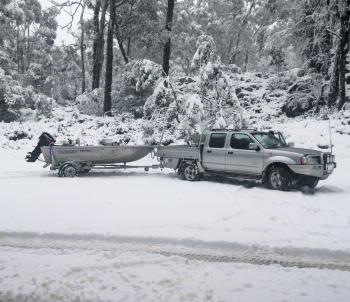
John Peck and his band of fishos love a bit of winter angling.
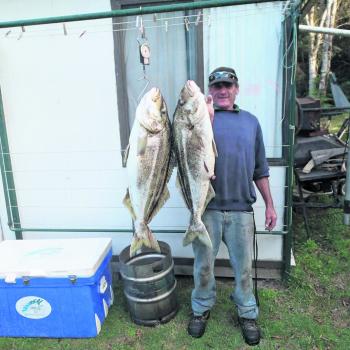
The late David Murray was the king of the West Coast stripies.
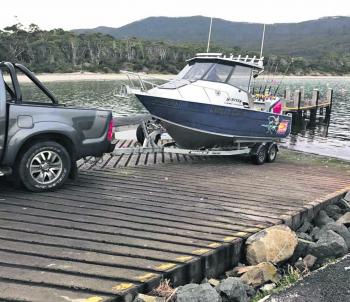
Mozza’s 6.5 Surtees is a fishing weapon and they have it very well sorted.
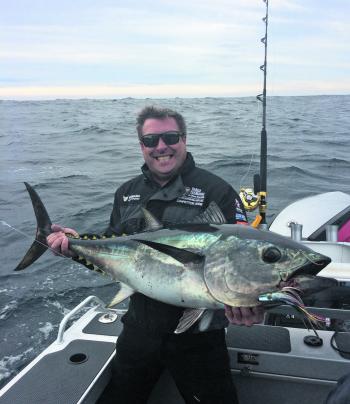
Benny ‘The Woo’ Wooster with a smile that good fishing and company will bring.
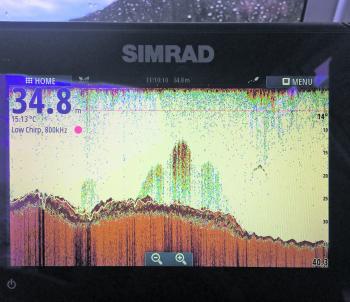
Find the baitfish and find the tuna. That’s what they say.

Arron Colgrave can find bream in the Derwent at will.
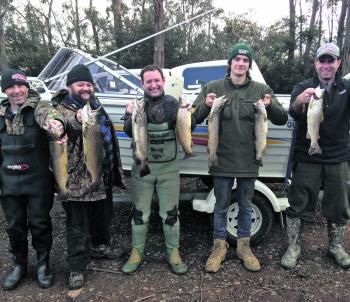
Winter fishing brings the smiles on the waters that are open all year round.

John Peck with an awesome winter trout from Woods Lake.
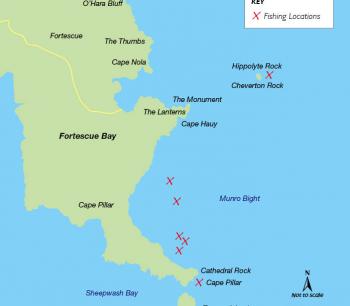
Map of fishing locations




